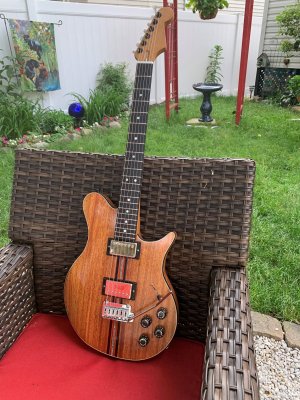Great discussion, and thanks for the info....
My last build was the guitar below using a Tiltback Strat headstock. A local luthier crafted a delrin nut for the neck, but warned that while using what he thought was the optimal nut material for tuning stability, it wouldn't be the "best" tuning stability. The neck originally came with the Graphtech nut.
The guitar has a Gotoh 510 2pt narrow string spaced bridge. My impression is that the tuning stability is "ok". When I put some nut lube on it, it's better.
I would have thought the tiltback would be superior since all the stings have a common break angle without the need for string trees. I wonder if a tiltback, with a lighter angle for the tiltback, would be optimal? It would seem to rectify the issue Stratamania spoke of, while providing a string tree'less string path. I think some Ibanez models have the lighter angled tiltback.
Regarding a straight headstock. I've been lucky that the Warmoth Tele Hybrid, using Hipshot staggered tuners, LSR nut and Wilkinson VS100 bridge, functions well without the need for string trees. By the way, of any non locking trem guitar I have, this guitar holds the best tuning. The 1st W I built was a Tele. While it has a standard Tele bridge, even with the same Hipshot staggered tuners set, it needed a string tree for the high E string.
View attachment 63316



